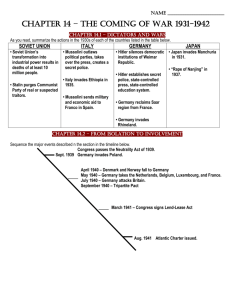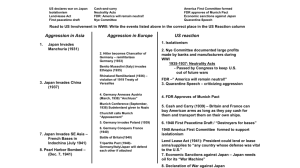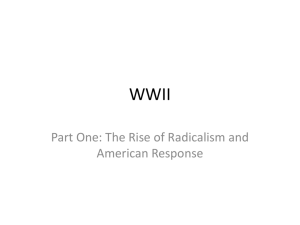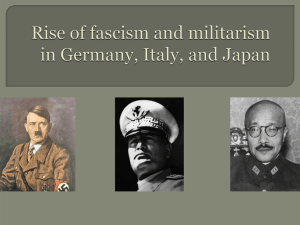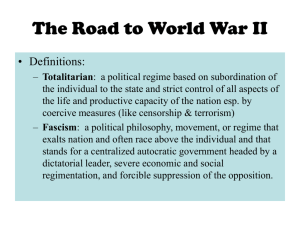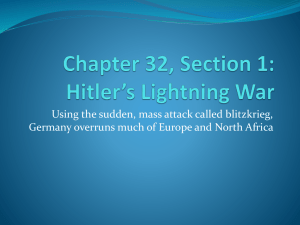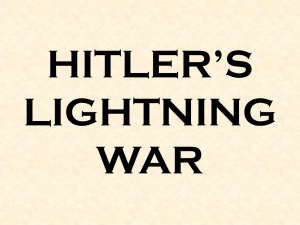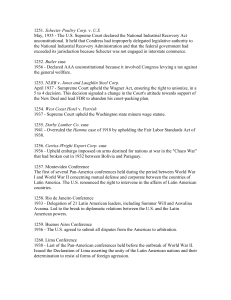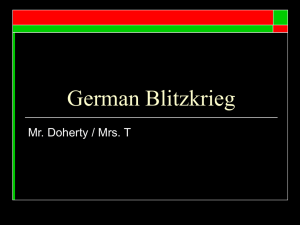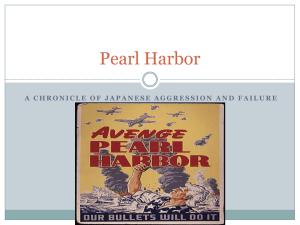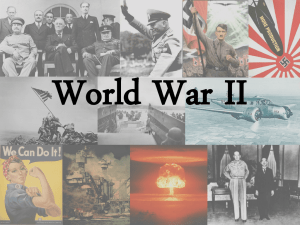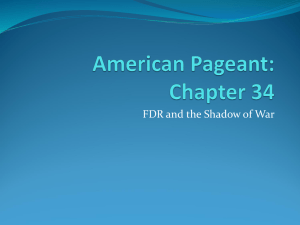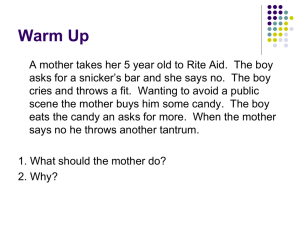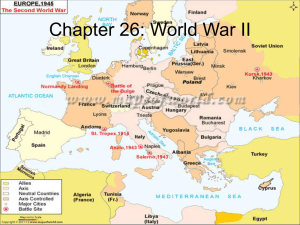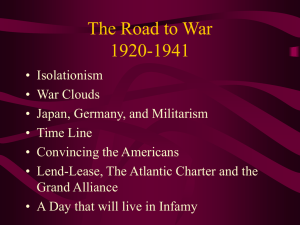Interactive Timeline Causes of WWII guide
advertisement
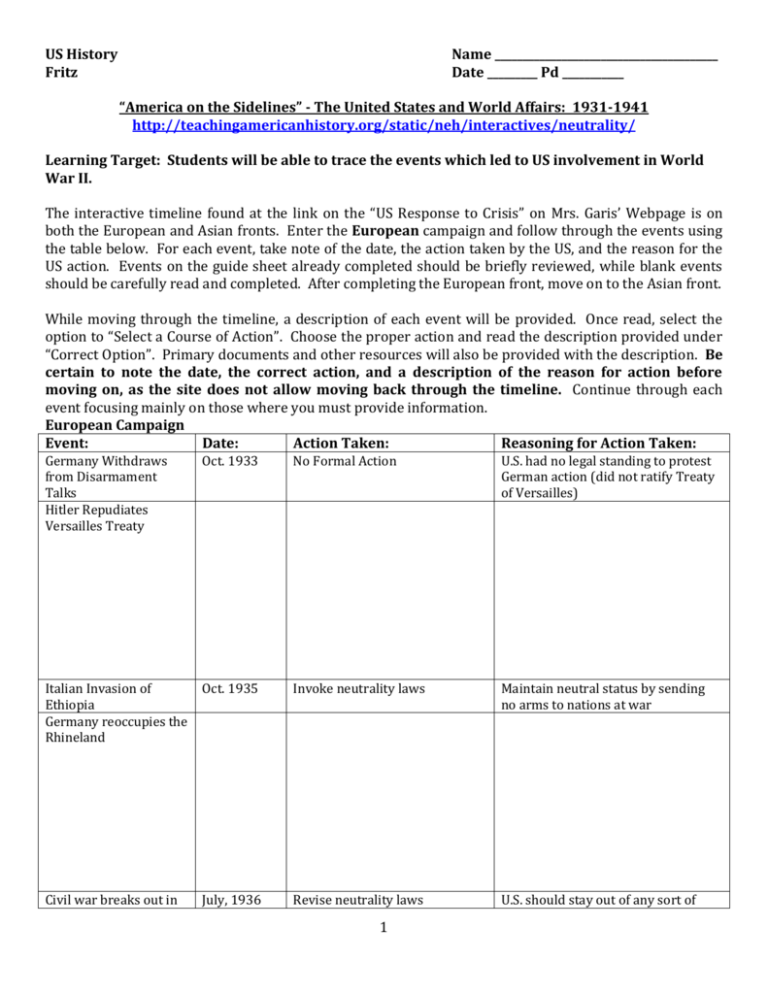
US History Fritz Name ________________________________________ Date _________ Pd ___________ “America on the Sidelines” - The United States and World Affairs: 1931-1941 http://teachingamericanhistory.org/static/neh/interactives/neutrality/ Learning Target: Students will be able to trace the events which led to US involvement in World War II. The interactive timeline found at the link on the “US Response to Crisis” on Mrs. Garis’ Webpage is on both the European and Asian fronts. Enter the European campaign and follow through the events using the table below. For each event, take note of the date, the action taken by the US, and the reason for the US action. Events on the guide sheet already completed should be briefly reviewed, while blank events should be carefully read and completed. After completing the European front, move on to the Asian front. While moving through the timeline, a description of each event will be provided. Once read, select the option to “Select a Course of Action”. Choose the proper action and read the description provided under “Correct Option”. Primary documents and other resources will also be provided with the description. Be certain to note the date, the correct action, and a description of the reason for action before moving on, as the site does not allow moving back through the timeline. Continue through each event focusing mainly on those where you must provide information. European Campaign Event: Date: Action Taken: Reasoning for Action Taken: Germany Withdraws from Disarmament Talks Hitler Repudiates Versailles Treaty Oct. 1933 No Formal Action U.S. had no legal standing to protest German action (did not ratify Treaty of Versailles) Italian Invasion of Ethiopia Germany reoccupies the Rhineland Oct. 1935 Invoke neutrality laws Maintain neutral status by sending no arms to nations at war Civil war breaks out in July, 1936 Revise neutrality laws U.S. should stay out of any sort of 1 Spain foreign war Germany annexes Austria Czech crisis and Munich Conference Hitler threatens Poland Oct. 1938 Expand armed forces FDR: “America needs to be prepared for any eventuality” Germany dismembers Czechoslovakia March, 1939 No formal action Denounced German aggression, but we weren’t prepared for stronger measures Italy invades Albania Germany invades Poland April, 1939 No formal action Not vital to America’s defense Germany invades April, 1940 No formal action U.S. believed Britain & France would 2 Denmark & Norway Germany invades low countries & France defeat Germany France surrenders Start of the “Blitz” Sept., 1940 No formal action Italy invades Greece Oct. 1940 Send aid to allies British gold reserves run low Germany invades Yugoslavia and Greece Jan. 1941 Send aid to allies April 1941 Send aid to allies June 1941 Send aid to allies Though sympathetic, Americans opposed further involvement Token of respect for Greece’s fight against the Axis War could spread and eventually threaten the U.S. Barbaric invasion is sign of Germany’s attempt at world conquest British suffer staggering losses at sea Germany invades Soviet Union Greer incident 3 Any defense against Hitler is vital to our own security Kearny incident Germany & Italy declare war on the US Oct. 1941 Revise neutrality laws Right of self-defense Date: Action Taken: Reasoning for Action Taken: Japan invades Jehol province Japan renounces naval treaty restrictions Promotes autonomy movement in North China Dec. 1932 No formal action Dec. 1934 No formal action Nov. 1935 No formal action No desire to offer more than disapproval of Japanese action Japan had right to withdraw from treaty U.S. would “closely observe” Japanese actions, but take no harsh measures Japan signs antiComintern pact Nov. 1936 No formal action Asian Campaign Event: Japan invades Manchuria 4 Though deeply troubling, Japan had every right to manage its own diplomatic affairs War breaks out between Japan and China Panay incident Japanese offensives in China Japanese offensives in Southern China Fighting between Japanese & Soviet forces Closing of the Burma road Japan occupies northern Indochina Japan occupies Southern Indochina May 1938 Embargo strategic materials Oct. 1938 Send aid to China July 1939 No formal action July 1940 No formal action Sept. 1940 Embargo strategic materials Japan proposes East Sept. 1941 Reject Japan was bombing civilian areas in China Protest to Japan violating China’s “open door” U.S. is more concerned with events in Europe U.S. tries to convince Britain to reopen the road Japan planned to use area as stage for further attacks Acceptance would look like approval 5 Asia settlement Japan proposes “Modus Vivendi” Attack on Pearl Harbor Nov. 1941 of Japanese occupation of China Broken codes showed that war was being planned anyway Reject 6
